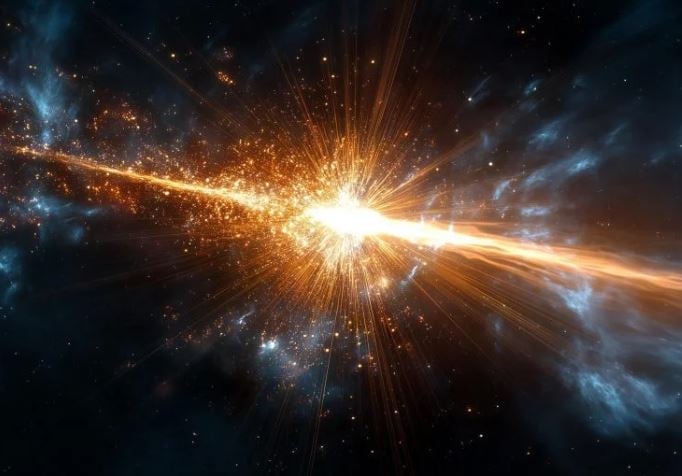On December 27, 2004, a powerful gamma-ray burst from a magnetar some 30,000 light-years away was detected by a series of satellites. The event, considered one of the brightest explosions ever observed in the Milky Way, released an enormous amount of energy, equivalent to the entire amount of energy produced by the Sun in 250,000 years. In particular, scientists confirmed that the explosion produced a mass equivalent to that of a planet in heavy elements - including gold and platinum.
According to a study published in the Astrophysical Journal Letters, a team of scientists from Columbia University has provided convincing evidence to answer one of the most controversial questions in astrophysics for decades: Where did the heaviest elements in the universe, such as gold and platinum, really come from?

Photo: SciTechDaily.
Unlike light elements like hydrogen and helium that formed shortly after the Big Bang, and intermediate elements like oxygen and iron that were created in the cores of ordinary stars, elements heavier than iron (Fe) require extreme physical conditions beyond the capabilities of supernova explosions to be created. For many years, scientists believed that neutron star mergers were the main source of these elements. However, the discovery of the 2004 explosion has opened up a potential “candidate”: magnetars.
A magnetar is a special type of neutron star, characterized by an extremely powerful magnetic field—10 trillion times stronger than a regular refrigerator magnet. In the 2004 event, the magnetar SGR 1806-20 produced a massive gamma-ray burst. Following the main gamma-ray burst, the European Space Agency’s INTEGRAL space telescope detected a weaker burst of radiation lasting several hours. This phenomenon was not fully explained at the time.
But now, a team at Columbia University has shown that this lingering radiation is actually a signal of radioactive decay from newly formed heavy elements through a nuclear chain reaction called the r-process. This reaction occurs when the outer layer of the magnetar is torn apart in the explosion, allowing new atoms to be synthesized.
Anirudh Patel, who ran computer simulations in late 2024, found that the light signal from 2004 was consistent with the gamma-ray model of radioactive decay of superheavy elements. The team estimates that at least 10% of all gold, platinum, and other precious metals on Earth could have originated from similar magnetar explosions.
“We may be wearing atoms on our wrists that were forged in a violent cosmic explosion tens of thousands of light years ago,” said Professor Brian Metzger, who led the research team. “It was the accumulation of stellar outbursts throughout the history of the Galaxy that helped form the precious minerals on our planet.”
The discovery also establishes that magnetars are not only powerful gamma-ray sources, but also extremely efficient “element forges” in the universe. This is only the second event in the history of science, after the neutron star merger in 2017, to be confirmed to be capable of forming superheavy elements through a clear physical mechanism.
The research results not only change the current scientific view on the origin of precious elements on Earth, but also open up a new direction of research on the key role of magnetars in the chemical evolution of the universe.
More interestingly, what was once considered a myth in alchemy - such as turning matter into gold - is now a scientific reality taking place in the middle of the universe, in the heart of exploding stars tens of thousands of light years from Earth.
Source: https://doanhnghiepvn.vn/cong-nghe/vu-no-sao-tu-nam-2004-tao-ra-luong-vang-tuong-duong-mot-hanh-tinh-chi-trong-nua-giay/20250514084935150




















































![[Maritime News] More than 80% of global container shipping capacity is in the hands of MSC and major shipping alliances](https://vphoto.vietnam.vn/thumb/402x226/vietnam/resource/IMAGE/2025/7/16/6b4d586c984b4cbf8c5680352b9eaeb0)













































Comment (0)